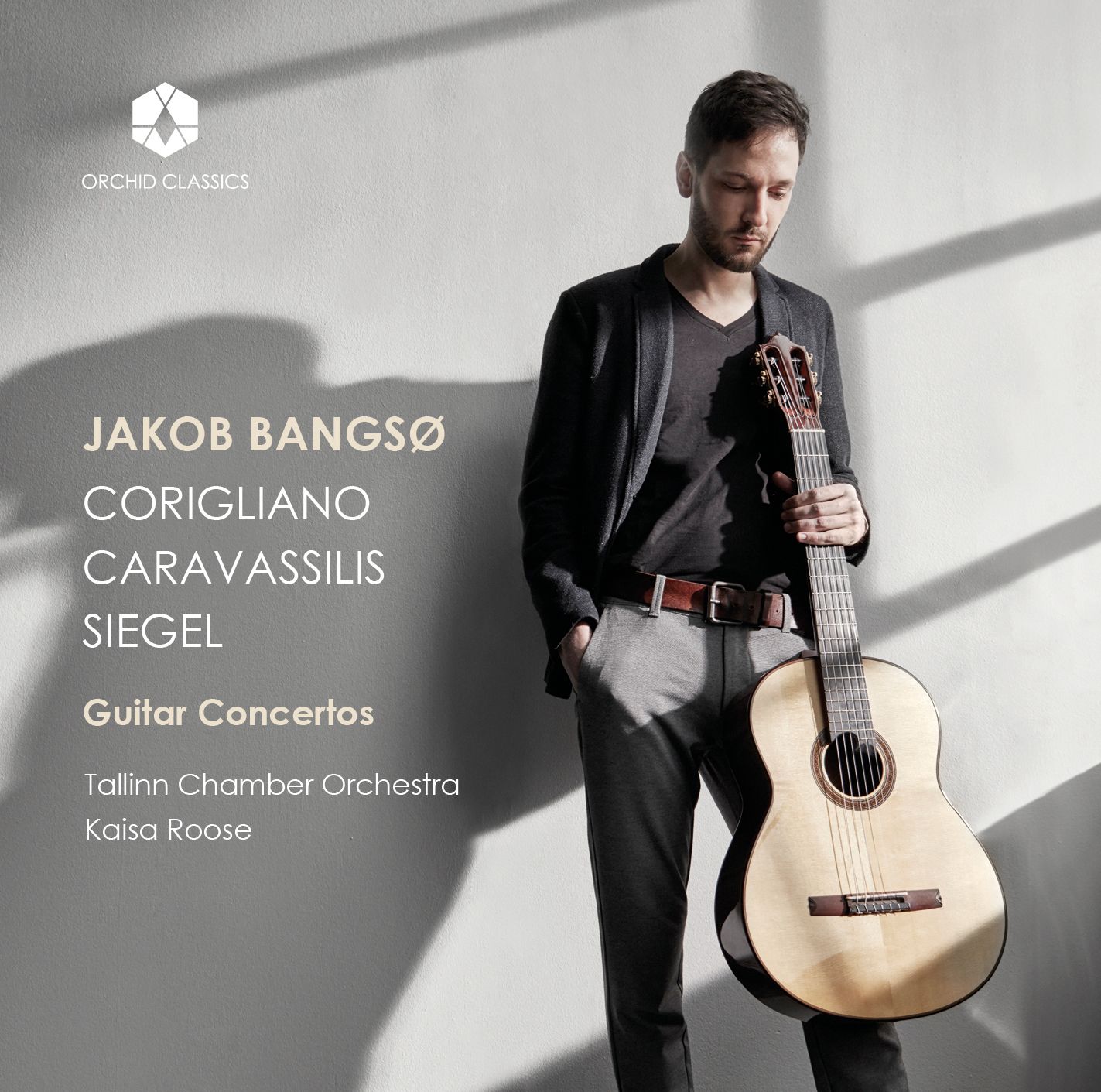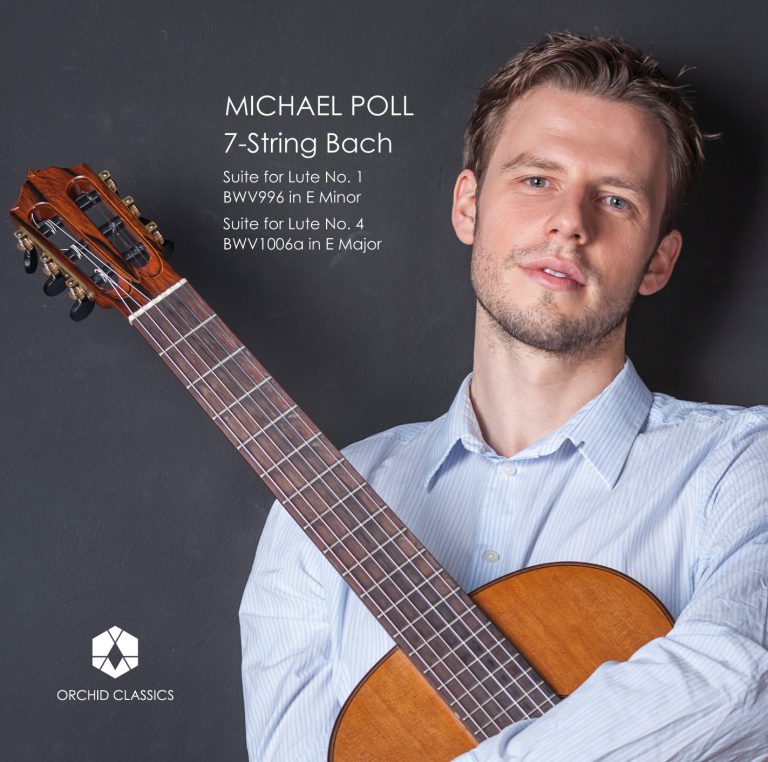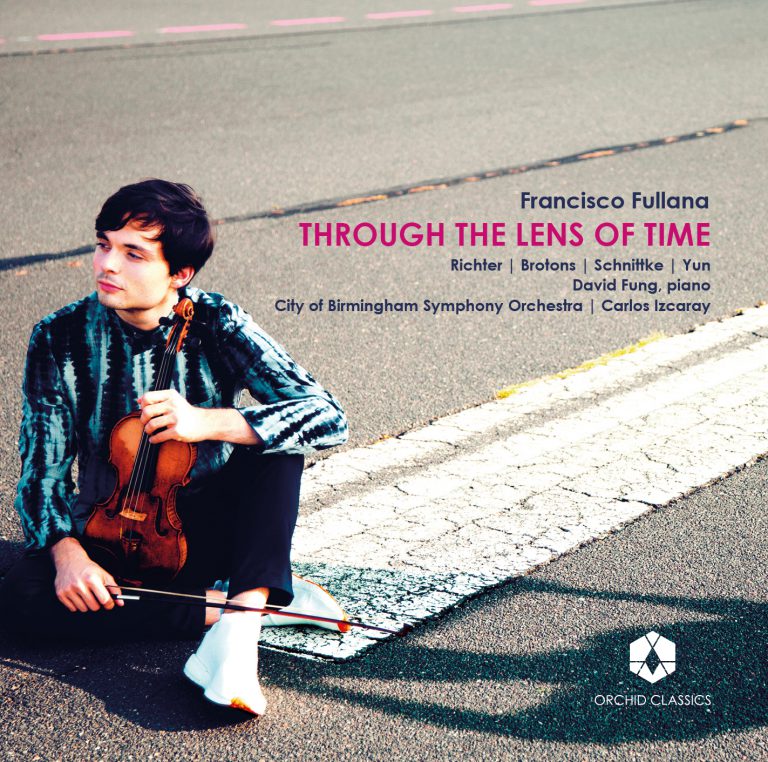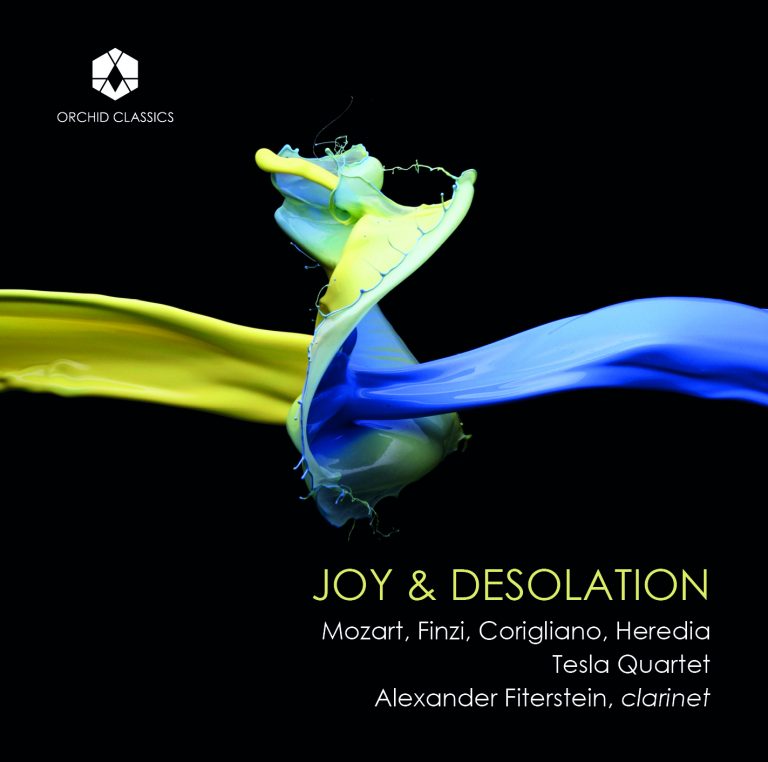Artist Led, Creatively Driven

Guitar Concertos
Jakob Bangsø, guitar
Tallinn Chamber Orchestra
Kaisa Roose, conductor
Release Date: September 4th 2020
ORC100142
John Corigliano (b.1938)
1 Troubadours (1993) 23.36
Variations for Guitar and Chamber Orchestra
Constantine Caravassilis (b.1979)
Saudade (2018)
Concerto for Guitar and Orchestra*
2 I. Teneramente 8.58
3 II. Presto e Giocoso 4.22
4 III. Adagietto 7.24
5 IV. Cadenza; Con Slancio 8.42
Wayne Siegel (b.1953)
6 Chaconne (2016) 18.33
Concerto for Guitar and Chamber Orchestra*
Total time 71.39
Jakob Bangsø, guitar
Tallinn Chamber Orchestra
Kaisa Roose
*World premiere recording
These guitar concertos are unified by more than their instrumentation. The two more recent works by Constantine Caravassilis and Wayne Siegel, written for Jakob Bangsø, were in part inspired by John Corigliano’s Troubadours, but the connections between these works go even deeper. The themes of nostalgia and memory recur throughout this album. Corigliano’s nostalgia for the innocence of his early output drew him towards the guitar, and he explores the music of the past in the resultant work. Caravassilis’s choice of the title Saudade is an explicit allusion to this theme: ‘Saudade’ is a Portuguese word suggestive of a bittersweet memory, suffused with nostalgia. Siegel also uses past models in his Chaconne, in which he conjures up the impression that the guitarist is searching his memory for the work’s melody.
Born in New York in 1938, John Corigliano strives for a sense of inclusivity in his music, with an emphasis on respect for his performers and audiences. As a result, his style often combines appealing elements such as tonality and lyricism, as well as theatrical and virtuosic gestures, alongside more modernist devices. Corigliano has described his early style as a “tense, histrionic outgrowth of the ‘clean’ American sound of Barber, Copland, Harris and Schuman”. This was followed in the 1970s by a move away from conventional notation to an “architectural” approach, encompassing serial and aleatoric processes, abstract scores, and microtonal effects.
When the guitarist Sharon Isbin approached John Corigliano about writing a guitar concerto, the composer had serious reservations. Corigliano admits that he was not a fan of much contemporary guitar music, and that he did not possess an intimate understanding of the instrument. Isbin was undeterred, and eroded the composer’s doubts by sending him scores, recordings and letters in the hope of creating a vision of what the concerto could become. Corigliano began to focus on the immediacy and popularity of the guitar, and its ability to speak directly to audiences: “Lyrical, direct, and introspective, it has a natural innocence about it that has attracted amateurs and professionals, young and old.” This in turn reminded the composer of the youthful enthusiasm with which he approached his earlier works: “… the idea of a guitar concerto was, for me, like a nostalgic return to all the feelings I had when I started composing – before the commissions and deadlines and reviews. A time when discovery and optimistic enthusiasm ruled my senses.”
The title and conception of the work stemmed from one of Isbin’s letters, in which she enclosed articles about troubadours and, in particular, famous women troubadours (known as trobairitz): medieval poet-musicians based in the south of France. This image inspired Corigliano to contemplate the act of serenading or singing to someone, and the concerto has a lyrical quality to it as a result, although it is not a direct emulation of the music of the era. As Corigliano explains: “By writing for chamber orchestra, with some of the instruments placed offstage, I was able to achieve the balance I desired between soloist and orchestra… While this work utilises some of the flavour of that time in the solo writing and percussion, it is more concerned with the idea of the troubadour rather than a display of early techniques.” Even so, the main theme varied during the work is “an original troubadour-like melody” that includes, at its end, a quotation from the song A chantar by La Comtessa (Beatritz) de Dia, a 12th-century trobairitz.
Troubadours (1993) is in three sections: two slower sections framing a quicker central episode. During the ethereal opening passages the guitar and ensemble ebb and flow, overlapping and exchanging material, the melody wafting between them until the soloist alone plays the theme, joined by the ensemble for lyrical variations. Offstage percussion heralds the start of the rhythmic, evocative second section, with double reed instruments used to mimic medieval shawms (precursors of today’s oboe). There is a spontaneous, vivid quality to this section, as though we are in the midst of a bustling medieval marketplace overhearing snatches of different conversations and activities, culminating in offstage horns leading into the guitar cadenza. This cadenza diffuses the boisterous atmosphere, drawing the listener into a more introspective mood. At the end of the cadenza, the soloist reprises the troubadour theme in a slower, decorated guise. It is supported by a set of seven chords, taken up and repeated by the orchestra in the manner of a chaconne, before dissolving into the misty, chromatic opening sonority. Although distinct, the chords are derived from the main theme, enabling the two to meld together seamlessly, ending the work with sinuous, mysterious fragments of sound receding into the distance.
Both Constantine Caravassilis and Wayne Siegel took Corigliano’s Troubadours as a model for their works composed for Jakob Bangsø. When Bangsø approached Caravassilis about writing a guitar concerto for him, the composer responded by suggesting that he first familiarise himself with the instrument by writing something smaller-scale. Like Corigliano, Caravassilis was acutely aware that there was much to learn about the instrument before embarking on a full-size concerto, and he gained a more intimate knowledge of the guitar through the composition of his solo Prelude in 2016. Caravassilis then set about composing his Saudade, a through-composed concerto in four, seamless sections, premiered by Jakob Bangsø in Tallinn on 19 May 2018.
Caravassilis explains of the work’s title: “Even though there is no exact translation of the original Portuguese word, Saudade represents the deepest of desires for something that cannot exist in the present. It is a journey through the yin and yang of the emotions one experiences when a memory of the past resurfaces.” Caravassilis builds the work from two main themes, one a simple motif inspired by lullabies sung to the composer by his grandmother, and the other based on a Greek folksong entitled Kaneloriza. Both themes are explored in the opening movement, Teneramente, with the guitar articulating the motifs and commenting upon the orchestral material, in what the composer refers to as a curatorial role.
In the quick-fire second movement, the guitar and orchestra take on combative roles, at odds with one another, the two motifs either disguised or heard simultaneously in counterpoint. The third-movement Adagietto is perhaps the most overtly connected to the work’s title, evoking “feelings of reminiscence, separation, emptiness, absence”. This is most vividly apparent in the first part of the movement, after which the guitar takes on what the composer describes as the role of “brother’s keeper” – someone responsible for taking care of a friend or relative. In this case, the guitar soothes the orchestra with positive memories of the main motifs, before establishing an ostinato of increasing momentum, heard in parallel with the repetition of the first motif. A guitar cadenza follows, summarising the moods and material of the concerto so far and setting the scene for the finale, in which the motifs are treated contrapuntally, bringing the work to a resounding close.
John Corigliano’s evocation of earlier styles, including the chaconne, in Troubadours, inspired Wayne Siegel to explore similar terrain in his Chaconne of 2016. The work is dedicated to Jakob Bangsø, with whom Siegel collaborated closely during its composition. A chaconne is a type of ever-extendable variation form comprising short units, each of which usually ends with a cadence before moving immediately onto the next. A recurring bass-line provides the foundation of the work, whereas in a passacaglia the recurring theme may be used in the upper voices as well as in the bass. These forms had their roots in the 16th century, when there were several chaconne styles across Europe, germinating in Spain and Italy and blossoming in Germany, France and England. A hybrid style of chaconne combines aspects of these traditions.
Siegel’s one-movement Guitar Concerto is a strict chaconne, and the composer describes the piece beginning “with the soloist searching his memory, trying to recall a forgotten melody. Once he has ‘remembered’ the 10-bar melody, it is repeated consistently and regularly as a ground bass with changing instrumentation and varying textures”. He adds: “I found it both challenging and inspiring to compose a work with only one simple melody, recalling the words of Igor Stravinsky: ‘My freedom thus consists in my moving about within the narrow frame that I have assigned to myself for each one of my undertakings.’”
© Joanna Wyld, 2020
Award-winning classical guitarist Jakob Bangsø has established himself as one of Denmark’s most gifted and versatile instrumentalists. Active as a solo recitalist, chamber musician and soloist with orchestra, his wide and constantly expanding repertoire ranges from early music to newly commissioned works.
A top prize winner in several international guitar competitions around Europe, the year 2014 alone saw him winning First Prize at the Berlin International Guitar Competition, First Prize and Audience Award at the Concours International de Guitare “Ville d’Antony” in Paris and First Prize at the Nordhorn International Guitar Competition in Germany. Further awards include the Second Prize at the IV Seville International Guitar Competition, Third Prize at the “José Tomás” Competition in Spain and many others.
With a keen interest in contemporary music, he continues to be involved in a number of collaborative projects with composers in Denmark and abroad, and he has premiered dozens of works. His collaboration with the Danish/American composer Wayne Siegel resulted in a soloist-led Chaconne which he premiered in 2017 with the ensemble of the Royal Library in the Queen’s Hall in Copenhagen. The same year, a larger orchestration of this concerto, as heard on this album, was premiered with the Tallinn Chamber Orchestra (TCO) along with the Estonian premiere of John Corigliano’s Troubadours. His commissioning of Greek/Canadian composer Constantine Caravassilis’s guitar concerto Saudade, which he premiered with the TCO in 2018, is another testament to Bangsø’s sincere interest in finding unique composers that resonate with his artistic personality. His 2018 solo album Connect (Dacapo Records) presented five world premiere recordings of works for guitar and electronics, written for Bangsø, by composers Tine Surel Lange, Andreja Andric, Klavs Kehlet Hansen, Wayne Siegel and Kaj Duncan David.
He has appeared with the Aarhus and Aalborg Symphonies, the Pärnu City Orchestra, Tallinn Chamber Orchestra, the Diamond Ensemble, Orchestre Camerata Lutécia, amongst others, including performances of Rodrigo’s Concierto de Aranjuez, the Girard, Corigliano, Siegel and Caravassilis Concertos.
Amongst an impressive list of accolades, Bangsø was the first guitarist ever to receive the coveted Young Elite career grant from the Danish Arts Council in 2015. Furthermore, he has been recognized with honours and awards including the 75th Anniversary Grant of the Augustinus Foundation, the Ejnar Hansen Award, the Thøger Rasmussen Memorial Award, the Makwarth’s Music Award, the Rebild Music Prize and many others.
Jakob Bangsø was born in Hjørring, Denmark, in 1988 and received his first guitar lessons at the age of nine. He completed his studies with Frederik Munk Larsen at the Royal Academy of Music in Aarhus and, as a recipient of the prestigious German DAAD scholarship, with Roberto Aussel at the Hochschule für Musik und Tanz in Cologne.
Bangsø plays on a 2015 Bogusław Teryks guitar and is endorsed by Augustine Strings.
Kaisa Roose has collaborated with major ensembles in Europe including the Esbjerg Ensemble, Figura Ensemble, Ensemble 2000, Aarhus Sinfonietta, the Tallinn Chamber Orchestra and the Pärnu City Orchestra. She has given world premieres and has recorded works by noted Danish composers Per Nørgård and Hans-Henrik Nordstrøm.
Roose is a graduate of the Royal Danish Academy of Music where she studied conducting with Michel Tabachnik and has participated in masterclasses by Kurt Sanderling and Pierre Boulez. During her studies in Copenhagen, Roose conducted the Copenhagen Philharmonic as well as the Odense, Aalborg and Helsingborg Symphony Orchestras. Additionally, she has been engaged by the Royal Danish Theater and the Malmö Music Theater in Sweden, the National Opera Theater in Estonia, the Brussels Philharmonic and the Catalonia National Orchestra in Barcelona. She has appeared before audiences in several countries including Denmark, Spain, Belgium, Sweden, Ireland, Finland, Costa Rica and Ecuador.










